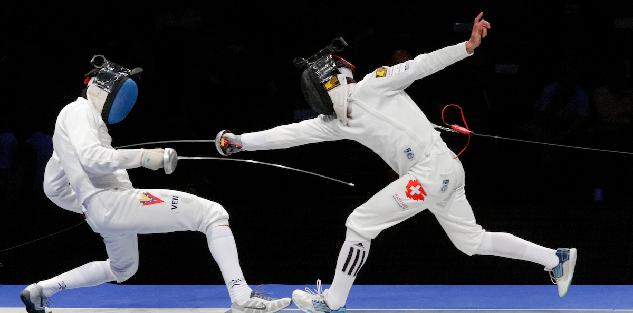Out of all the sports and martial arts I have ever done Fencing is my absolute favorite. I have performed the art for about eight years now, and know it inside and out. I have a certain level of expertise to the art of swordsmanship which, like all martial arts, developed at the rate of the work I put in–a lot of work lead me to become, very good very fast.
Fencing is not generally thought of as a martial art–this is again due to the bias that martial arts are all from Asia. However, fencing is a western martial art. Even though it is now done for sport, just as karate and taekwondo are, there was once a time where fencing was one of the most dangerous and violent martial arts in the world. Until about the 18th or 19th centuries fencing duals were to the death.
This changed once the community realized that the great masters kept dying because they kept fighting each other to prove who was better. This lead to duals being fought to first blood, which in turn resulted in all white attire like that which exists today out of tradition. As society “progressed” and first blood was “too violent” and “uncivilized” duels became matches which were fought with dulled blades covered in chalk to a score. Rules developed to keep score, and as technology progressed so did the art. With electricity came electric fencing, using lights and wires to decide who scored, which evolved to what it is today. As a result of the advent of rules the martial art became less and less as it was intended and has become much closer to a sport with the current popular styles.
Nowadays fencing is organized and run by the United States Fencing Association in the US, and by the International Fencing Federation (FIE because it is in French which is the official language of fencing).

There are three weapons in fencing:epee, foil, and sabre (the best). All three are derived from the rapier–a long sword developed during the latter part of the middle ages, and was wielded as a thrusting weapon. The foil is the most direct descendant. When a rapier would break one had two options: buy a one (expensive), or simply resharen the blade into a new tip. The latter became the foil. The epee is derived from the foil, and the sabre is a hybrid between Europe’s rapier, and the Middle East’s scimitar–a large curved sword meant for slashing and cutting.
Even though it would take far too long to explain all the rules of fencing I will get into the basics.
Epee is is a point weapon, meaning you must hit with the tip of the weapon, and you must do so hard enough to push the button on it in, completing the electrical circuit. In epee you can hit anywhere on the body from the head to the bottom of the foot. Both, or one of the fencers can receive a point, or touch, in a single go. Epee is the “slow” weapon.

Foil is also a point weapon, but is more restrictive. The target is constrained to the neck and torso, and only one person can score a touch at a time. Who gets the point is determined by ”right of way,” or the right to attack.

Sabre is a slashing weapon. You can hit with any part of the weapon except the bell guard that protects the hand due to dangers to the opponent. The target is everything above the waist except the hands. Sabre is the “fast” weapon, and also has right of way. In both foil and sabre right of way is held by whoever is moving forward, blocks the attack, or knocks the the opponent’s blade out of the way. There is much more to it but that could be its own post.

Fencing is the best thing to ever happen to me. It requires physical fitness, mental acuity, and still contains the spiritual aspects that martial arts have if you are trained correctly–i.e. Not in the modern Russian or popular style. Give it a try and you’ll be hooked.
